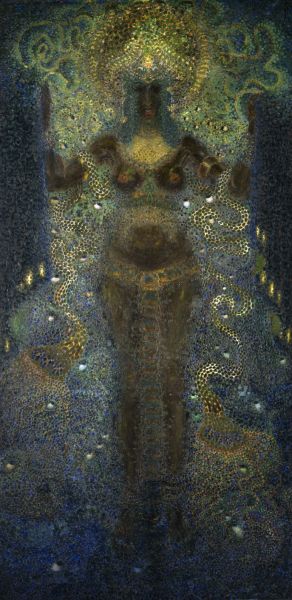|
|
Woman with Serpents. 1909

Kalmakov Nikolai,
Wax paints on canvas
213,8 х 106,7
State Russian Museum
Пост. в 1944 из Инспекции по охране памятников, Ленинград
Annotation
This exotic and suggestive painting, with its magical ornamental design, is a typical example of the oeuvre of Nikolai Kalmakov in the late 1900s and early 1910s. Oriental mythology was a common motif in the artist’s works. This particular picture possibly depicts the goddess Kali, a fierce and terrifying aspect of Devi — wife of Siva and personification of the formidable and destructive aspect of his divine energy. At the end of a kalpa or periodical life cycle, Kali (Sanskrit: black) shrouds the world in darkness, contributing to its destruction. Kali was a devouring, destructive goddess and a mighty patroness. This work by Kalmakov, like other works by him, represents one of the varieties of Russian symbolist art, which echoes one of the Art Nouveau.
Author's Biography
Kalmakov Nikolai
Kalmakov, Nikolai Konstantinovich
1873, Nervi, Italy — 1955, Chelles, near Paris
Painter, graphic artist, theatrical designer. Studied at the School of Jurisprudence in St Petersburg (until 1895). Did not receive a profes¬sional artistic education. Independently studied classical art in Italy (1895–1903). Contributed to exhibitions (from 1906). Designed for theatres in Leningrad (from 1908). Illustrated books (from 1913). Cofounder of the Yulia Slonimskaya-Sazonova Puppet Theatre in Pet¬rograd (1915). Lived in Constantinople, Tallinn, Helsinki, Brussels and Paris (from 1918).

